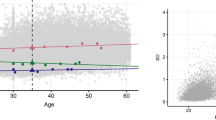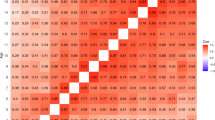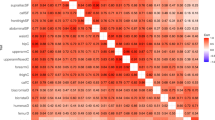Abstract
OBJECTIVE: Male familial correlations in body mass index (BMI) were studied using a large nationwide dataset of Swedish military conscripts examined at age 18–19 y.
DESIGN: Record linkage was performed between Sweden's Military Service Conscription Register and the Multiple-Generation Register, enabling the identification of 92 869 families containing at least two brothers. Data on BMI at conscription was available for 196 743 sons and for 19 972 fathers. Pairs of relatives were used to estimate Pearson correlation coefficients for BMI, and to examine whether there are BMI intervals that show particularly strong familial resemblance.
RESULTS: All biological family relations showed highly significant correlations for BMI: 0.28 (95% CI 0.27–0.29) for father–son pairs; 0.36 (0.35–0.37) for full-brothers, 0.21 (0.18–0.24) for maternal half-brothers, and 0.11 (0.08–0.14) for paternal half-brothers. Also, a significant correlation, of 0.06 (0.01–0.11), was found for non-biological quasi father–son relations. Full-brothers were more similar with respect to BMI at age 18 than father–son pairs, and maternal half-brothers were more similar than paternal half-brothers. The familial risk of having BMI values above or below various cut-offs was found to be equally strong for low BMI as for high BMI values.
CONCLUSION: The almost twice as strong BMI correlation between maternal half-brothers as between paternal half-brothers illustrates the importance of factors of non-additive genetic origin, to the familial aggregation of BMI. The significant BMI association found between biologically unrelated individuals from the same family emphasizes that assortative mating (and regional clustering) should be taken into account when the heritability of BMI is estimated.
This is a preview of subscription content, access via your institution
Access options
Subscribe to this journal
Receive 12 print issues and online access
$259.00 per year
only $21.58 per issue
Buy this article
- Purchase on Springer Link
- Instant access to full article PDF
Prices may be subject to local taxes which are calculated during checkout




Similar content being viewed by others
References
World Health Organization. Obesity: preventing and managing the global epidemic. Report of a WHO consultation. World Health Organization Technical Report Series no. 894 2000.
Sørensen TI, Holst C, Stunkard AJ . Adoption study of environmental modifications of the genetic influences on obesity Int J Obes Relat Metab Disord 1998 22: 73–81.
Stunkard AJ, Harris JR, Pedersen NL, McClearn GE . The body-mass index of twins who have been reared apart New Engl J Med 1990 322: 1483–1487.
Maes HH, Neale MC, Eaves LJ . Genetic and environmental factors in relative body weight and human adiposity Behav Genet 1997 27: 325–351.
Rasmussen F, Johansson M, Hansen HO . Trends in overweight and obesity among 18-year-old males in Sweden between 1971 and 1995 Acta Paediatr 1999 88: 431–437.
SAS Institute Inc. SAS procedures guide, Version 6 3rd edn Cary, NC: SAS Institute Inc. 1990.
Sykes B, Irven C . Surnames and the Y-chromosome Am J Hum Genet 2000 66: 1417–1419.
Dabelea D, Hanson RL, Lindsay RS et al. Intrauterine exposure to diabetes conveys risks for type 2 diabetes and obesity: a study of discordant sibships Diabetes 2000 49: 2208–2211.
Johansson M, Rasmussen F . Birthweight and body mass index in young adulthood: the Swedish Young Male Twins Study Twin Res 2001 4: 400–405.
Vogler GP, Sørensen TI, Stunkard AJ, Srinivasan MR, Rao DC . Influences of genes and shared family environment on adult body mass index assessed in an adoption study by a comprehensive path model Int J Obes Relat Metab Disord 1995 19: 40–45.
Perusse L, Chagnon YC, Weisnagel SJ, Rankinen T, Snyder E, Sands J, Bouchard C . The human obesity gene map: the 2000 update Obes Res 2001 9: 135–169.
Author information
Authors and Affiliations
Corresponding author
Rights and permissions
About this article
Cite this article
Magnusson, P., Rasmussen, F. Familial resemblance of body mass index and familial risk of high and low body mass index. A study of young men in Sweden. Int J Obes 26, 1225–1231 (2002). https://doi.org/10.1038/sj.ijo.0802041
Received:
Revised:
Accepted:
Published:
Issue Date:
DOI: https://doi.org/10.1038/sj.ijo.0802041
Keywords
This article is cited by
-
The promise of new anti-obesity therapies arising from knowledge of genetic obesity traits
Nature Reviews Endocrinology (2022)
-
Environmental mismatch and obesity in humans: The Jerusalem Perinatal Family Follow-Up Study
International Journal of Obesity (2021)
-
Genotype–covariate interaction effects and the heritability of adult body mass index
Nature Genetics (2017)
-
Current review of genetics of human obesity: from molecular mechanisms to an evolutionary perspective
Molecular Genetics and Genomics (2015)
-
Conditional and joint multiple-SNP analysis of GWAS summary statistics identifies additional variants influencing complex traits
Nature Genetics (2012)



